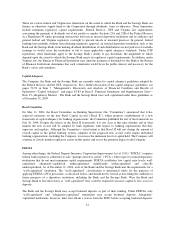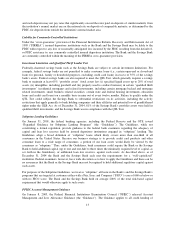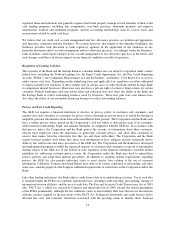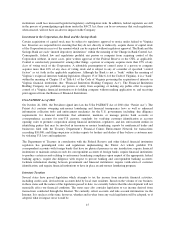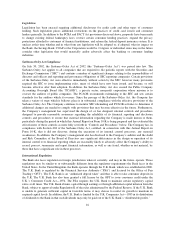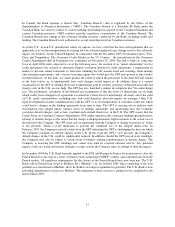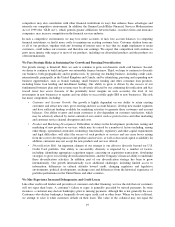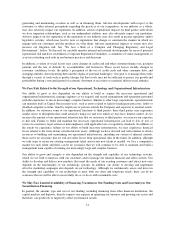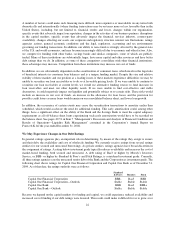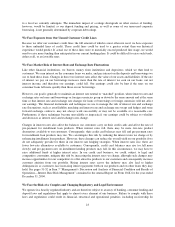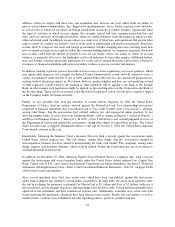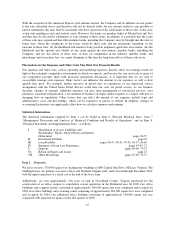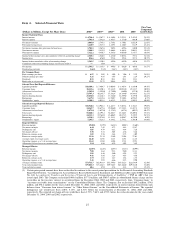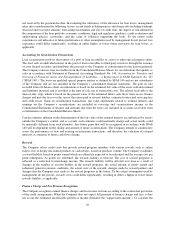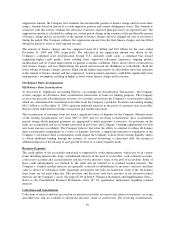Capital One 2004 Annual Report Download - page 44
Download and view the complete annual report
Please find page 44 of the 2004 Capital One annual report below. You can navigate through the pages in the report by either clicking on the pages listed below, or by using the keyword search tool below to find specific information within the annual report.generating and maintaining accounts as well as in financing them. Adverse developments with respect to the
consumer or other external perceptions regarding the practices of our competitors, or our industry as a whole,
may also adversely impact our reputation. In addition, adverse reputational impacts on third parties with whom
we have important relationships, such as our independent auditors, may also adversely impact our reputation.
Adverse impacts on our reputation, or the reputation of our industry, may also result in greater regulatory and/or
legislative scrutiny, which may lead to laws or regulations that change or constrain the manner in which we
engage with our customers and the products we offer them. Adverse reputational impacts or events may also
increase our litigation risk. See “We face a Risk of a Complex and Changing Regulatory and Legal
Environment”, below. To this end, we carefully monitor internal and external developments for areas of potential
reputational risk and have established a Corporate Reputation Committee, a committee of senior management, to
assist in evaluating such risks in our business practices and decisions.
In addition, a variety of social factors may cause changes in credit card and other consumer finance use, payment
patterns and the rate of defaults by accountholders and borrowers. These social factors include changes in
consumer confidence levels, the public’s perception of the use of credit cards and other consumer debt, and
changing attitudes about incurring debt and the stigma of personal bankruptcy. Our goal is to manage these risks
through a variety of tools such as product design, but these tools may not be sufficient to protect our growth and
profitability during a sustained period of economic downturn or recession or a material shift in social attitudes.
We Face Risk Related to the Strength of our Operational, Technology and Organizational Infrastructure
Our ability to grow is also dependent on our ability to build or acquire the necessary operational and
organizational infrastructure, manage expenses as we expand, and recruit management and operations personnel
with the experience to run an increasingly complex business. Similar to other large corporations, operational risk
can manifest itself at Capital One in many ways, such as errors related to failed or inadequate processes, faulty or
disabled computer systems, fraud by employees or persons outside the Company and exposure to external events.
In addition, we outsource some of our operational functions to third parties; these third parties may experience
similar errors or disruptions that could adversely impact us and over which we may have limited control. As we
increase the amount of our operational infrastructure that we outsource to third parties, we increase our exposure
to this risk. Failure to build and maintain the necessary operational infrastructure can lead to risk of loss of
service to customers, legal actions or noncompliance with applicable laws or regulatory standards. In addition, to
the extent we experience failures in our ability to build necessary infrastructure, we may experience financial
losses related to the write-downs of infrastructure assets. Although we have devoted and will continue to devote
resources to building and maintaining our operational infrastructure, including our system of internal controls,
there can be no assurance that we will not suffer losses from operational risks in the future. In addition, although
we take steps to retain our existing management talent and recruit new talent as needed, we face a competitive
market for such talent and there can be no assurance that we will continue to be able to maintain and build a
management team capable of running our increasingly large and complex business.
Our ability to grow and compete is also dependent on the strength and capability of our technology systems,
which we use both to interface with our customers and to manage our internal financial and other systems. Our
ability to develop and deliver new products that meet the needs of our existing customers and attract new ones
depends on the functionality of our technology systems. In addition, our ability to develop and implement
effective marketing campaigns also depends on our technology. Although we continuously assess and invest in
the strength and capability of our technology to meet both our short and long-term needs, there can be no
assurance that we will be able to successfully do so, or do so with sustainable costs.
We May Face Limited Availability of Financing, Variation in Our Funding Costs and Uncertainty in Our
Securitization Financing
In general, the amount, type and cost of our funding, including financing from other financial institutions, the
capital markets and deposits, directly impacts our expense in operating our business and growing our assets and
therefore, can positively or negatively affect our financial results.
21



